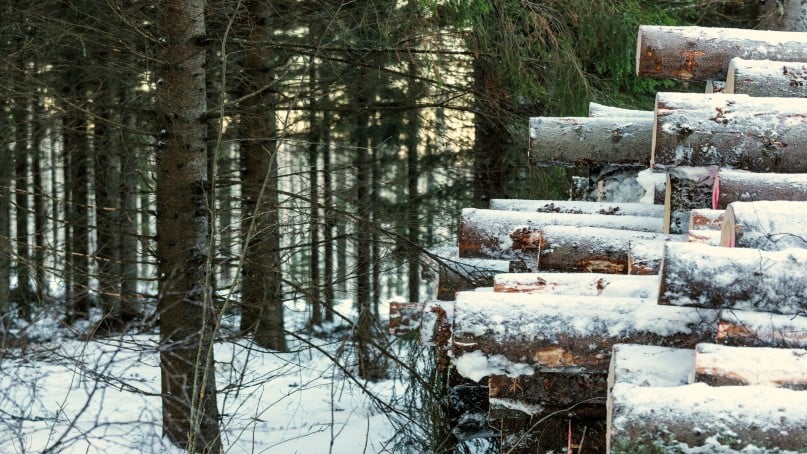An imposing pile of spruce logs is lying on the roadside as the result of recently completed thinning operations. Pine and birch piles can be seen on the farther side of the field. “Both large and small thinning was carried out on seven stands in all,” says forest owner Petri Niemelä.
His wife, Katri Paananen, says the two had been planning to thin the stands for a couple of winters. “When our forest specialist Ari Hylkilä promised there was still time to harvest the trees this winter, it was easy to take him up on the offer.”
Niemelä and Paananen had read about the new pricing method that Metsä Group introduced in all of Finland in November. Opting for stem volume based pricing in wood trade means that the forest owner is paid for whole trunks, and the traditional division into log and pulpwood grades is disregarded. “We found the new method interesting, so I asked Ari for an offer,” says Niemelä.

Stem price based on volume and quality
In pricing based on stem volume, the final price of wood trade is determined according to the average volume of the felled trees after harvesting. The offer is based on a price matrix showing the forest specialist’s estimate of the felling site’s average volume and the corresponding stem price per cubic metre.
From the price matrix, the forest owner can see how the price per cubic metre changes if the actual volume differs from the estimate. If the average volume exceeds that used in the offer, the buyer pays more for the trees. If it is less, then the payment is also less.
Niemelä and Paananen’s forests are well-managed and grow well. For example, the couple have meticulously carried out preliminary clearing. According to Hylkilä, forests like this are best suited to pricing based on stem volume. “If the forest has been managed well and preliminary clearing has been taken care of, there are no small-diameter trees growing beneath the predominant species, risking a lower average stem volume,” says Hylkilä.
Since some of the stands had both older trees that had been growing there for 60 years or so, and some had younger 45-year-old trees with a smaller diameter, different stem-volume based prices and price matrices were used in the offer.
Cutting based on the needs at the time of harvesting
In Niemelä and Paananen’s forest, wood trade progressed rapidly from agreement to actual felling. The agreement was concluded in November, and in January, felling had already been completed and some of the trunks were on their way to the converting unit. The spruce logs were transported to the Vilppula sawmill, while softwood and birch pulp was delivered to the Äänekoski bioproduct mill.
Things don’t always move as fast as this. Especially in stands marked for winter felling, harvesting may be delayed if the conditions are unsuitable. When using pricing based on stem volume, the buyer does not need to estimate the market situation a year or two ahead, since the trees can be cut according to the mills’ and sawmill’s current needs.

No need to supervise piles any longer
Niemelä and Paananen found their first stem volume-based pricing trade to be a positive experience. “The amount of wood and euros matched the estimate pretty closely. We got the familiar harvesting operators on site, and the results of the felling look good,” says Niemelä.
The forest owners were also pleased that they no longer had to worry about which piles the trees ended up in after felling. “In our experience, quality is often used as an excuse. At times, it is bending in the trunks, at others rot that leads to a trunk being assigned to the pulpwood pile,” says Paananen.
Hylkilä points out that in stem volume-based pricing, it is the buyer who is responsible for unexpected grade defects detected in connection with felling. “After the trade, the only thing that matters to the wood seller is the stem volume of the felled trees.”
Interest in the new approach
Metsä Group introduced pricing based on stem volume across Finland in November 2021. According to Hylkilä, the new pricing model has aroused interest among forest owners. The most common question that Hylkilä hears is which of the two pricing models is ultimately more profitable to the forest owner.
“To help with decision making, the forest owner can also request an offer based on wood grade pricing, but there really shouldn’t be much of a difference between the two pricing models. In principle, they are more or less comparable,” says Hylkilä.
“Pricing based on stem volume will probably become more popular, as forest owners grow more familiar with it. I will certainly bring it up more frequently in the future,” says Hylkilä. Niemelä and Paananen also encourage other forest owners to consider pricing based on stem volume. “If you have a suitable stand in your forest, this approach is definitely worth trying.”
This article was originally published in issue 1/2022 of Metsä Group’s Viesti magazine.
Text: Maria Latokartano
Photos: Tomi Aho
